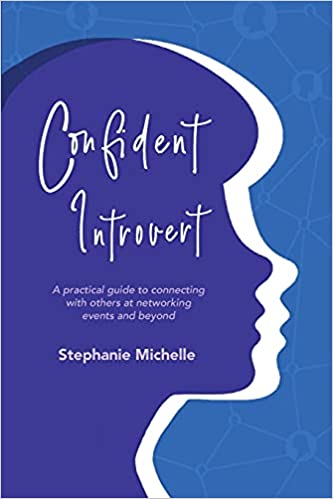Table of Contents
Figuring out how to make friends as an adult can feel daunting. It can even make you kinda nostalgic about how easy it was to make friends as a kid.
One second you spot someone on the swing set, and the next you’re splitting a juice box and playing hide and go seek.
So why does trying to figure out how to make friends as an adult feel so awkward sometimes?
Whether you soak up the energy of a room, or feel the need to recoil for some down time after a big social event, almost everyone struggles with the awkward reality that is…professional networking (dun, dun, DUN).
“‘Networking’ is just another term for how to make friends as an adult.” – Stephanie Michelle, Author of ‘Confident Introvert‘
Even if you’re a socially anxious extrovert, gregarious introvert, or somewhere in between as an ambivert, you will certainly learn something from this free chapter of ‘The Confident Introvert‘ on how to actually enjoy making friends as an adult.
Here’s how to make building friendships as an adult feel as easy and fun as it was your school days:
The Confident Introvert: Chapter 1

In a 2018 online survey of 100 SF Bay Area professionals who self-identified as introverts, here is what they had to say about their experiences with networking.
*The quick stats:
- 75% of introverts associate the term “networking” with “anxiety” or “dread.”
- 53% don’t attend networking events because they’re afraid they won’t enjoy them.
- 31% attend networking events but don’t enjoy them.
- And yet, 92% believe networking is a valuable skill.
That last part? They’re not wrong.
According to the Bureau of Labor Statistics, 80 percent of job positions are filled either internally or through networking. For us introverts, there’s a significant gap between what we value and the actions we take (or not) dictated by our comfort zone.
And as much as we may enjoy solitude, there is a dark side.
In the last fifty years, the rate of loneliness is estimated to have doubled in the United States. While advancements in technology allow people to stay in touch and make new friends near and far, studies show that human connection facilitated through screens isn’t enough. We both need and want more for ourselves.
But the question remains: why is it that even hearing the word “networking” is enough to transform so many of us into a ball of frenzied and flustered feelings? Enough to stifle us from enjoying the experience if we even get out the door to experience them at all?
As we’ll learn later in this book, networking and other social events can be inherently draining for those who are wired to gain energy from creative, oftentimes solo, pursuits—introverts.
We tend to associate networking with overwhelm, energetic expenditure, and high demand for skills that counter our natural inclinations. Plus, they don’t suit how we typically like to form deep-rooted bonds with others.
So, our minds create a little shortcut for us. We begin to equate networking with all things slimy, fake, and transactional. And given the incompatibility between the demands of networking and an introvert’s natural skill set, we see ourselves as bad at networking: awkward, meek, or shy.
But here’s the truth. These mental shortcuts are wrong.
Introverts can be confident. Networking can be authentic
Yup, introverts can rock stages, speak with others with ease at events, and not only embody but also feel authentic confidence. Confidence is a sense of self-assurance that allows us to take risks in areas where we could fall flat on our faces or invite our wildest dreams to come to life.
Success is never guaranteed, but having a strong sense of confidence allows us to be resilient to those times when things go haywire. Having a baseline level of confidence also keeps us grounded when things go exceedingly well, as our egos are less likely to inflate when we do experience the sweet fruits of our labor.
With confidence, we become centered, happy, and relatively open to new experiences, ways of doing things, and people.
Anyone—both introverts and extroverts—can reach this doorway. And yes, we can network in an authentic way.
How to Make Friends as an Adult

Think of networking as friend-making as an adult. Networking is nothing more than forging authentic relationships with other ambitious folks.
You know that one coworker of yours who always seems genuinely happy and at ease at holiday parties The one who seems to have no trouble asking for help on a project by inserting themselves in water cooler chatter?
Interpersonal connection is at the root of networking for business, and when networking is done right, there’s little distinction between the two. Networking is simply another way to connect with people who just so happen to be ambitious and business-minded.
My Story: From Shy Loner to Confident Introvert
Growing up in a blue-collar family who worked in hospitality and law enforcement, my first glimpse at white collar life was an aunt who worked as a banking executive. It was then that I decided that I wanted to go that route.
The idea of working in an office and wear semi-formal attire gave me visions of power suits, high-rise buildings, and catered lunches. I imagined being one of those executives who rose through the ranks, worked hard, and achieved coveted results.
It felt like a benchmark to aspire to – far away but possible. I didn’t have any connections in the type of work I wanted to do, but I realized if I could at least get my foot in the door, I’d have a chance.
I applied to hundreds of internships after college, tweaking my cover letter and resume along the way to see which versions got the most responses. When it came time to apply for full-time “real” jobs, I had a few templates that got results.
But it still meant sending out about a dozen applications just to score one phone interview. However, once I got my foot in the door, and could meet someone in real life, it was a done deal. I was more than likely offered the job.
Discovering The Secret Side Door

I vividly recall a conversation with someone I was dating early in my career. I explained that I had introductory phone interviews lined up during each lunch break that week and was heading out to a round-three in-person interview that Friday.
“You interview for jobs?” he asked, perplexed.
“Doesn’t everyone?” I asked, equally confused.
You apply for a job. That’s how you get them. Just like you buy food at a grocery store, or (ideally) learn things at school.
“Every job I’ve gotten I’ve been invited to. People who I know think of me and maybe I speak with someone and they just offer me the job. I’ve never had to interview.”
It sounded like he had gamed the system.
Here I was, working an unpaid part-time “job” as a professional job seeker, raking in the interviews only to learn that the interview process wasn’t actually mandatory. I was a pro at my process, but I wasn’t exactly being invited to jobs by people I knew. But to be fair, I didn’t really know that many people.
They say “who you know” gets you your next job.
After that, I gradually started attending more events and meeting more people. Networking. And after a while, I learned I didn’t have to work my tail off to land a new job. I saw that opportunities could come to me, and they can come to you, too.
I didn’t know it at the time, but step by step I gained the knowledge and strategies to further my transformation from shy loner to confident introvert. Throughout my time coaching and consulting, I’ve reverse engineered my process, identifying the key breakthroughs and steps to true, sustainable growth. This book will show you how.
Buckle Up! Here Is Your Confident Introvert Roadmap
Step 1: Identify.
We’ll begin by identifying your core personality and discussing how to get to know yourself better before you meet others. What’s at the root of how you show up in the world?
Step 2: Recharge.
Then, we’ll help you recharge and feel confident in conserving your energy before you begin to meet others. We’ll identify tips and tactics for making the most out of your social engagements and downtime.
Key Concept: Solitude Sandwich
” [A solitude sandwich] consists of two slices of bread, or periods of solitude, and peanut butter, or your socially stimulating activity in between. Solitude sandwiches come in all sizes. Maybe it looks like one hour of solitude on either end of a three-hour event. Or, maybe it’s taking one full day to just be yourself both before and after a three-day conference. Your solitude sandwich lets you be unapologetically reclusive when you need or want to be so you can store up your energy reserves.
You’ll know the sandwich ratio is ideal when you don’t hit a wall. The solitude time serves more as a soft place to settle than as a crash landing from an empty tank. This can even happen online! It’s actually a newurbandictionary.com entry called zoom fatigue, and a solitude sandwich is the perfect antidote.”
- For example, my ‘Sandwich’ technique, where you strategically schedule short moments of downtime in between social engagements. This will ensure you are rested, replenished, and energetic in meetings, and will protect you from feeling completely drained by the end of the day.
Step 3: Reframe.
After that, we’ll dive into reframing the thoughts that are holding you back so you can be more open to connection. If you have any limiting beliefs (we all do) they will come up in this chapter, and you’ll have the opportunity to redefine them.
Step 4: Relate in Person.
Then comes relating to people in person at networking events and beyond. I’ll share best practices for common social situations that make conversation go so much more smoothly and deeply.
Step 5: Nail Your First Impression
When you’re meeting someone for the first time, how do you make a great first impression?
There can be a fine balance between being authentic and outspoken or being terse and putting people off before they have a chance to get to know you. We’ll now delve into some quick tips and concepts to maximize your chances of making your first impression count.
Here are Stephanie’s favorite tips for nailing your first impression at meeting or event:
Tip #1. Find and Own Your Voice
If you’re not yet convinced of your own confidence, it can show up in the sound of your voice.
Do you ever initially speak in a whisper without meaning to? Does your voice trail off before your sentence is finished? Do you find yourself making statements that sound more like questions?
This is called rising intonation, or uptalk, and it can make you sound less credible than you actually are. Practice speaking from your diaphragm with breath exercises, and build up your strength by enunciating consonant sounds such as “Puh-Tik-Uh” before an event in the privacy of your own home.
Also, be sure to stay hydrated so your vocal cords are able to carry a full-bodied, engaging sound.
Tip #2. The Sweetest Sound: Repeat Their Name
Always lead by embellishing your “hello,” with the person’s name. Hearing “Hello, Tom,” feels better (assuming their name is Tom!) than a blanket, one-size-fits-all greeting. A study from the US National Library of Medicine found that participants experienced more brain activity and engagement when they heard their name repeated in conversation.
Tip #3. Take Pause: Hold on the Hug
Not everyone you meet will be a hugger. For example, in France and Japan, hugging isn’t a standard greeting and rarely done in public.
In France, a kiss on each cheek is acceptable, whereas in Japan, a handshake will do. America can be hug-friendly but is also a melting pot of cultures.
So it is safe to greet for the first time with a “hello” and a handshake, and after your conversation, you can ask, “Are you a hugger?” before initiating the gesture.
Tip #4. Should You Relate or Dominate?
When first meeting someone it’s easy to dive into work and business talk, focusing on what gender sociologist Deborah Tannen calls “report” when what would serve us better is first establishing “rapport.”
Report is necessary for business goals and alignment, while rapport—developing familiarity—is necessary for relationship building.
To begin a conversation, you can ask how someone’s week has gone, how their holiday was, or if they have anything exciting coming up.
Tip #5. Are You Toasting with Water or Vodka?

Some industries and cultures find it acceptable to bond and build rapport over alcohol while others don’t. It’s really up to you to gauge your comfort level and not exceed a drink or two, or whatever amount will leave you relaxed but not intoxicated in a professional setting when making a first impression.
Also keep in mind that some people don’t drink alcohol at all for personal reasons. If this is the case, a coffee or tea shop will be a more comfortable choice since your meeting mate may feel less comfortable if there aren’t mocktails readily available at the bar.
I recommend getting comfortable networking without the social lubricant of alcohol in order for true confidence to be honed and shine through.
How to Make Friends as an Adult Online
Great news if you’re an introvert – you can now enjoy adult friend making from the comfort of your own couch, thanks to FREE digital tools like LunchClub, Bumble Biz, and Shapr.
Simply select the app of your choice and start swiping.
Have you figured out how to make friends as an adult? What are your favorite power networking tips and tricks? Let us know in the comments below!
About the Book

Networking doesn’t have to feel like a sales-focused event where you’re using people to get ahead. Create meaningful connections, easily strike up genuine conversations, and dazzle people with your natural charm.
In Confident Introvert, Stephanie Michelle shows you the key steps you’ll need to take to unlock your potential and win at networking. Within these pages, you’ll discover strategies that go beyond collecting business cards to find your natural confidence and connect with anyone.
Confident Introvert will help you build new friendships at online and in-person events for priceless career growth. Whether you’re looking to move ahead in your career or grow a company, this book will galvanize you into action and pave a clear path for your networking success.
About the Author

Stephanie helps professional women go from holding back to leading with confidence, getting raises, promotions & recognition.
To date, Stephanie has helped thousands of people celebrate their strengths, step into their authentic confidence, and make meaningful connections through speaking at places like Harvard University and 1:1 coaching.
To learn more, visit her website for a free gift, or join her group on Facebook.


